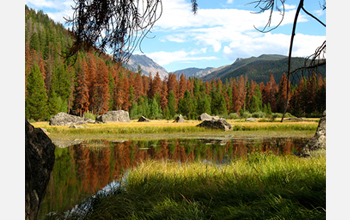|

Press Release 08-162
Pine Bark Beetles Affecting More than Forests

Beetles may be altering Rocky Mountain air quality and weather
September 24, 2008
Pine bark beetles appear to be doing more than killing large swaths of forests in the Rocky Mountains. Scientists suspect they are also altering local weather patterns and air quality. A new international field project, led by scientists at the National Center for Atmospheric Research (NCAR) in Boulder, Colo., is exploring how trees and other vegetation influence rainfall, temperatures, smog and other aspects of the atmosphere. Plants take in and emit chemicals that affect the air, and they also absorb varying amounts of incoming heat from the sun. When portions of a forest die, the local atmosphere can change in subtle ways. "Forests help control the atmosphere, and there's a big difference between the impacts of a living forest and a dead forest," says NCAR scientist Alex Guenther, a principal investigator on the project. "With a dead forest, we may get different rainfall patterns, for example." Launched this summer, the field project is scheduled to continue for four years over a region extending from southern Wyoming to northern New Mexico. Scientists plan to use aircraft and ground-based instruments, as well as computer models, to study interactions between the planet's surface and the atmosphere. The project, known as BEACHON (Bio-hydro-atmosphere interactions of Energy, Aerosols, Carbon, H2O, Organics and Nitrogen), is funded by the National Science Foundation (NSF), NCAR's sponsor. BEACHON will allow scientists to glean insights into such topics as cloud formation, climate change, and the cycling of gases and particles between the land and the atmosphere, according to Cliff Jacobs, program director in NSF's Division of Atmospheric Sciences. Plants emit water vapor, other gases, and microscopic particles that influence the atmosphere in subtle and complex ways. For example, some tiny airborne particles from plants rise into clouds and seed them, providing a surface for water droplets to adhere to and develop into raindrops. Greenhouse gases such as carbon dioxide (CO2), which is emitted in large quantities from beetle-devastated forests, combine with extra CO2 produced by human activities to influence the amount of heat from the Sun that reaches Earth or gets reflected back into space. Plants also emit chemicals known as volatile organic compounds that can interact with human-caused pollution to influence the formation of ground-level ozone, or smog, which affects both air quality and local temperatures. When large areas of trees are killed by pine beetles or other causes, these interactions are disrupted. This may change cloud and precipitation patterns for a decade or more, which can, in turn, further alter the land cover. Preliminary computer modeling suggests that beetle kill can lead to temporary temperature increases of about 2-4 degrees Fahrenheit. This is partly because of a lack of foliage to reflect the Sun's heat back into space. Scientists also believe that beetle kill stimulates trees to release more particles and chemicals into the atmosphere as they try to fight off the insects. This worsens air quality, at least initially, by increasing levels of ground-level ozone and particulate matter. Wildfires, clearcutting, and new development also affect the atmosphere by removing vegetation. But the impacts in each case can vary significantly, depending on the remaining vegetation and changes to soil conditions. The exchange of gases and particles between the surface and the atmosphere is critical in arid areas such as the western United States. Even slight changes in precipitation can have significant impacts on the region. "Here in the western United States, it is particularly important to understand these subtle impacts on precipitation," Guenther says. "Rain and snow may become even more scarce in the future as the climate changes, and the growing population wants ever more water." While other field projects have measured emissions from plants, BEACHON is unusual because it will continue for at least four years and cover an entire region. This will allow researchers to examine the impacts of emissions in different seasons and measure year-to-year changes. To conduct measurements, researchers plan to use specially equipped aircraft as well as towers that reach above the forest canopy to measure emissions at up to about 100 feet above the ground. Additional observations will come from a variety of soil and moisture sensors, instruments for gases and tiny particles, radars, and lidars, which are radar-like devices that use light instead of radio waves. "BEACHON will give us a very comprehensive picture of a forest's impact on the atmosphere," Guenther says. "But at this point, we don't know what the project will reveal. We may end up with more questions than answers." Organizations participating in the project include Colorado College, Colorado State University, Cornell University, Texas A&M University, and the universities of Colorado, Idaho, Minnesota, New Hampshire, and Washington, as well as the U.S. Forest Service, the Environmental Protection Agency, and universities in Austria, France and Japan.
-NSF-

Media Contacts
Cheryl Dybas, NSF (703) 292-7734 cdybas@nsf.gov
David Hosansky, NCAR (303) 497-8611 hosansky@ucar.edu

The National Science Foundation (NSF) is an independent federal agency that
supports fundamental research and education across all fields of science and
engineering, with an annual budget of $6.06 billion. NSF funds reach all 50
states through grants to over 1,900 universities and institutions. Each year,
NSF receives about 45,000 competitive requests for funding, and makes over
11,500 new funding awards. NSF also awards over $400 million in
professional and service contracts yearly.
 Get News Updates by Email Get News Updates by Email
Useful NSF Web Sites:
NSF Home Page: http://www.nsf.gov
NSF News: http://www.nsf.gov/news/
For the News Media: http://www.nsf.gov/news/newsroom.jsp
Science and Engineering Statistics: http://www.nsf.gov/statistics/
Awards Searches: http://www.nsf.gov/awardsearch/
| 


